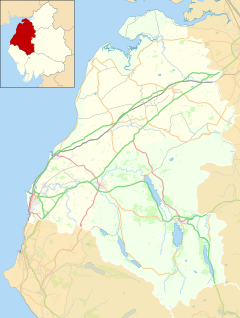
Back كيسويك، كمبريا Arabic كيسويك (بلده فى اليردال) ARZ کزیک، کامبریا AZB Keswick (lungsod sa Hiniusang Gingharian, Inglatera, Cumbria, lat 54,60, long -3,13) CEB Keswick, Cumbria Welsh Keswick Danish Keswick (Cumbria) German Keswick Spanish Keswick (Cumbria) Basque کزیک، کامبریا Persian
| Keswick | |
|---|---|
Location within Cumbria | |
| Population | 5,243 (2011)[1] |
| OS grid reference | NY270233 |
| Civil parish |
|
| Unitary authority | |
| Ceremonial county | |
| Region | |
| Country | England |
| Sovereign state | United Kingdom |
| Post town | KESWICK |
| Postcode district | CA12 |
| Dialling code | 017687 |
| Police | Cumbria |
| Fire | Cumbria |
| Ambulance | North West |
| UK Parliament | |
Keswick (/ˈkɛzɪk/ KEZ-ik) is a market town and civil parish in the Cumberland unitary authority area of Cumbria, England. Historically, until 1974, it was part of the county of Cumberland. It lies within the Lake District National Park, just north of Derwentwater and four miles (six kilometres) from Bassenthwaite Lake. The parish had a population of 5,243 at the 2011 census.
There is evidence of prehistoric occupation of the area, but the first recorded mention of the town dates from the 13th century, when Edward I of England granted a charter for Keswick's market, which has maintained a continuous 700-year existence. The town was an important mining area, and from the 18th century has been known as a holiday centre; tourism has been its principal industry for more than 150 years. Its features include the Moot Hall; a modern theatre, the Theatre by the Lake; one of Britain's oldest surviving cinemas, the Alhambra; and the Keswick Museum and Art Gallery in the town's largest open space, Fitz Park. Among the town's annual events is the Keswick Convention, an Evangelical gathering attracting visitors from many countries.
Keswick became widely known for its association with the poets Samuel Taylor Coleridge and Robert Southey. Together with their fellow Lake Poet William Wordsworth, based at Grasmere, 12 miles (19 kilometres) away, they made the scenic beauty of the area widely known to readers in Britain and beyond. In the late 19th century and into the 20th, Keswick was the focus of several important initiatives by the growing conservation movement, often led by Hardwicke Rawnsley, vicar of the nearby Crosthwaite parish and co-founder of the National Trust, which has built up extensive holdings in the area.
- ^ "Neighbourhood statistics" Archived 18 June 2015 at the Wayback Machine, Office for National Statistics, retrieved 18 June 2015
- ^ "Planning – Keswick Parish". Lake District National Park. 3 October 2016. Retrieved 30 July 2019.






